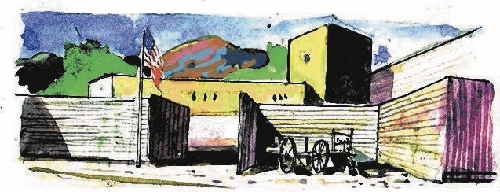Old boomtown Eureka still rich with history
One of the best preserved of Nevada's early mining towns, Eureka lies in the middle of the state between Ely and Austin on U.S. Highway 50, dubbed the Loneliest Road in America. The seat of Eureka County and its commercial center, the town boasts dozens of structures from the 1800s, most of them clustered in or near the historical downtown and still in use.
At 6,500 feet on the skirts of wooded mountains, Eureka makes a cool summer destination for heat-weary Southern Nevadans. The little town is 320 miles from Las Vegas by the shortest paved route, via Ely to U.S. 50 using Interstate 15, U.S. Highway 93, State Route 318 and U.S. Highway 6.
Rural byways and old mining roads fanning out from Eureka invite visitors to explore the Silver State's heartland.
Many of the county's scattered residents make their living in ranching and agriculture. Eureka draws folks from all around during one of its biggest events of the year, the Eureka County Fair, which starts Wednesday and runs through Aug. 14. The fair includes Western-style entertainment, barrel racing, team roping, and a livestock show featuring animals raised by area youngsters.
Eureka grew from the 1864 discoveries of deposits of ore containing lead, silver, gold and sometimes other metals.
Mining continues to be important to Eureka. Tour the open-pit gold mine at the edge of town to learn about modern gold mining.
The mineral discoveries drew people of many nationalities, immigrants willing to work in the mines, smelters and related industries. Soon the town had hotels, eateries, banks, stores, churches, newspapers, a narrow-gauge railroad, a red-light district, gambling halls, opium dens and at least 100 saloons.
Although diminished in size from its boomtown days, Eureka today is a better place to live than in yesteryear, when it was known as the "Pittsburgh of the West." Its many smelters extracted precious metals from ore but poured smoke laden with arsenic and lead fumes into the clear Nevada skies.
Woodcutters denuded the hills for 50 miles around Eureka, and charcoal kilns reduced the wood to fuel to feed the insatiable smelters.
In 1879, Eureka was the center of the short but deadly Fish Creek War, a struggle between smelter operators and charcoal makers over the price of the product.
The forests softening the outlines of the nearby mountains today regenerated in the century since Eureka's decline.
Eureka's first structures were made of canvas and wood. Frequent fires kept the town's volunteer firefighters busy.
In 1879, a particularly destructive conflagration left much of the city in smoking ruins. Because the only buildings that survived were constructed of stone or brick, the city rebuilt with more fire-resistant materials. After 1880, slate roofs replaced shingles, and heavy, hinged iron panels shuttered windows and covered doorways.
The red-brick, white-trimmed, two-story Eureka County Courthouse downtown is one of two 19th-century courthouses in the state still housing county government (the other is in Virginia City). Various businesses once occupied the adjacent brick annex. The courthouse retains its original pressed-tin ceilings, wooden wainscoting and decorative fixtures. An art gallery on the old building's south side displays a permanent county art collection and works by visiting artists.
Across the street on a corner, the Jackson House Hotel occasionally welcomes patrons in its Victorian-era restaurant and bar as it did when the neighboring opera house opened for a New Year's Eve costume ball in 1880. The opera house restoration some years ago retained many original features but updated the space for modern needs as a meeting center and an auditorium.
Learn more about Eureka's history at the two-story museum housed in the Sentinel newspaper's brick building just behind the courthouse. Still published, the weekly Sentinel survived competition from at least five other papers. Open daily through October from 10 a.m. to 6 p.m. and Tuesdays through Saturdays the rest of the year, the building houses early memorabilia, some displayed in scenes of businesses, a school room and rooms used by families at home.
A self-guided tour of historic Eureka is available online at www.rainesmarket.com. Click on the link to the tour for descriptions and photos of nearly 50 sites.
Margo Bartlett Pesek's column appears on Sundays.






















